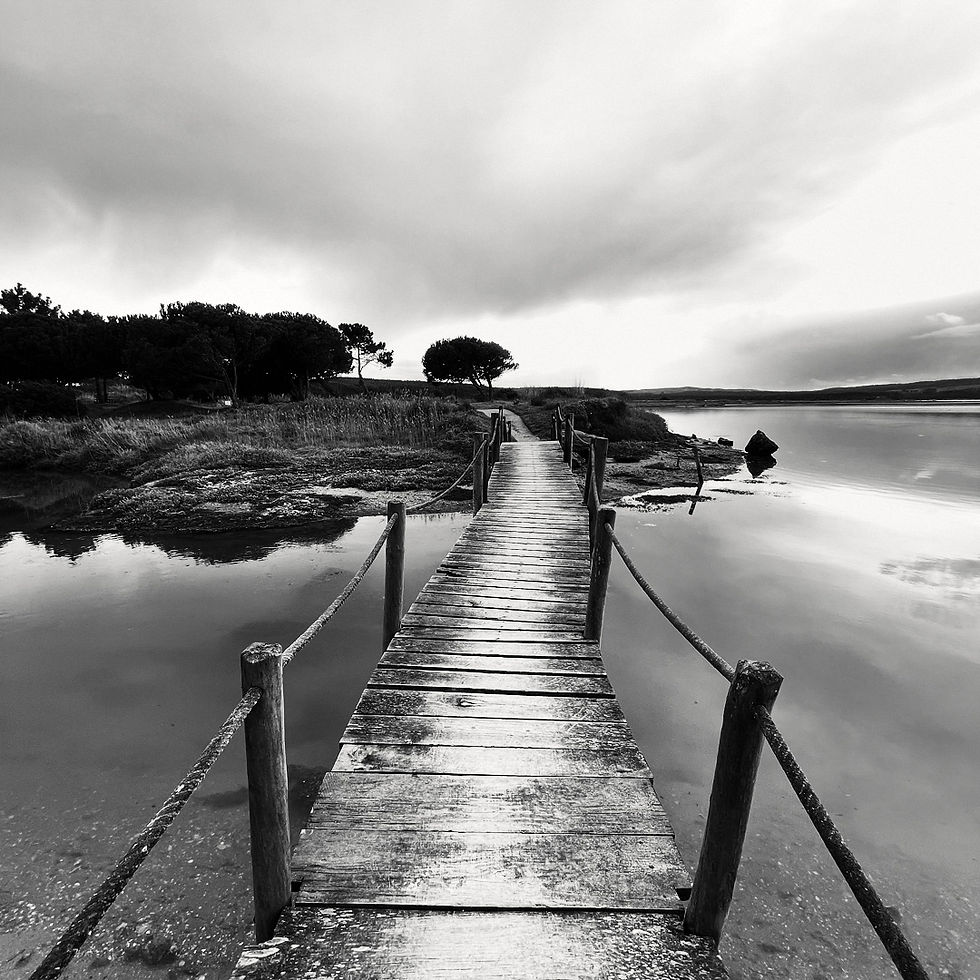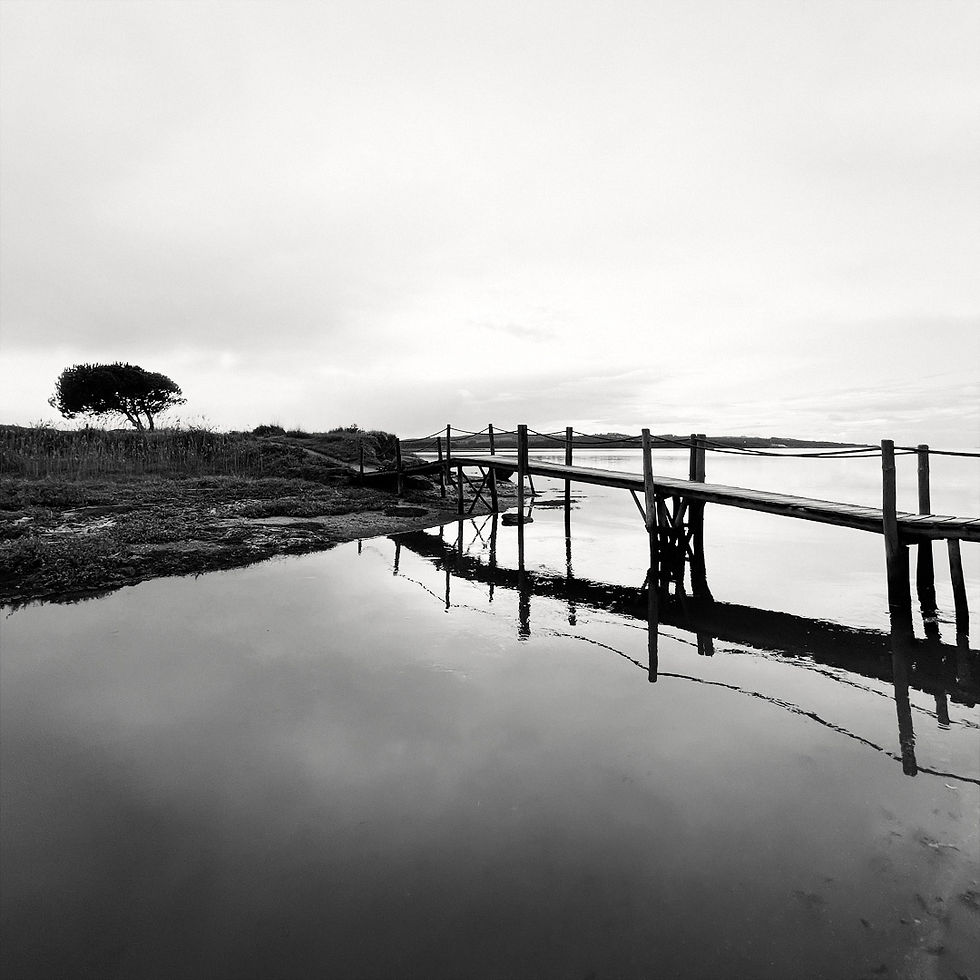Portugal: Exploring the Enchanting Óbidos Lagoon on the Silver Coast
- Olivier
- Apr 19, 2023
- 8 min read
Updated: Mar 16
Portugal's Silver Coast, also known as the Costa de Prata, is a region renowned for its stunning coastal landscapes and picturesque towns. Nestled within this natural paradise is the captivating Óbidos Lagoon, a hidden gem that enchants all who discover it.

© O. Robert
The Silver Coast of Portugal is more than just a destination. From the shimmering beaches to the historic towns and natural wonders, every corner of this region tells a story. Whether you're a history buff, a nature lover, or a photographer seeking inspiration, the Silver Coast promises a journey that will leave you with memories to cherish.
In this article, we will delve into the beauty and allure of the Óbidos Lagoon, a place where tranquility and natural wonder converge. A wonderful place for minimalist photography.
What is the Silver Coast
The Silver Coast, or "Costa de Prata" in Portuguese, is a picturesque coastal region of Portugal, stretching approximately 150 to 200 kilometers along the Atlantic Ocean. It begins north of Espinho and extends to Torres Vedras in the south. This region is renowned for its vast fine sandy beaches, invigorating Atlantic waters, and spectacular coastal landscapes, mixing steep cliffs and sandy expanses.
The Silver Coast owes its name to the unique interplay of light and water. The sun's rays dance on the ocean's surface, creating a silvery sheen that is particularly breathtaking during sunrise and sunset. This natural phenomenon has inspired poets, artists, and photographers for centuries, making it a beloved destination for those seeking tranquility and inspiration.

© O. Robert
The climate of the Silver Coast is temperate and maritime, characterized by hot, dry summers, and mild but humid winters, making it a popular destination throughout the year. Its beaches, popular for surfing, swimming, and other nautical activities, attract both tourists and locals.
The towns and villages along the Silver Coast are steeped in history and culture. Places like Aveiro, nicknamed the "Venice of Portugal", Nazaré, famous for its giant waves, and Óbidos, with its medieval castle, offer a fascinating glimpse into Portuguese heritage.
The Silver Coast is therefore a destination that combines natural beauty and cultural richness. Its calm atmosphere specific to the region, changing skies, and morning mists make it a particularly suitable area for photography. Read my article on Silver Coast here.
The Óbidos Lagoon
Known locally as "Lagoa de Óbidos," the lagoon is one of the most beautiful and distinctive natural formations in the region. It is the largest saltwater lagoon in Portugal and is located near the historic town of Óbidos.
This lagoon is an area of great ecological importance and a favored habitat for a variety of bird species and marine life. It is fed by several watercourses and extends to the Atlantic Ocean, renewing with the tides. The lagoon is separated from the ocean by a system of dunes, creating a unique environment where calm and shallow waters contrast with the more robust waves of the Atlantic.
In addition to its ecological richness, the Óbidos Lagoon is also a popular recreational area. It offers excellent conditions for various nautical activities such as sailing, kite-surfing, and canoeing. The beaches around the lagoon are prized for their beauty, cleanliness, and peaceful setting. They attract those seeking an alternative to the more frequented ocean beaches. Therefore, it is highly recommended to plan photography trips outside of the summer period.
Moreover, the Óbidos Lagoon houses one of the most beautiful coastal villages, Foz do Arelho, which I have featured in a dedicated article you can read here.

© O. Robert
Birdwatchers' Paradise
With its spectacular natural setting and biodiversity, the lagoon is an ideal place to visit for nature lovers and those looking to discover a quieter, more natural side of Portugal.
These optimal conditions provide a diverse habitat for wildlife. They attract a variety of birds, including marine and migratory species. The geographical features of the lagoon, such as its shallow waters and islets, also offer protection against predators, making it an ideal place for nesting and rearing young.
For migratory birds, the Óbidos Lagoon primarily serves as a vital resting and refueling point during their long journeys. It offers an abundance of food in the form of fish, crustaceans, and invertebrates.
For wildlife photographers, note that the lagoon is home to species such as flamingos, herons, ducks, avocets, sandpipers, stilts, and spoonbills, to name just a few of the most frequently observed.
Portugal Through the Lens | This stunning 89-page photo book is filled with a variety of evocative images that showcase the beauty and character of Portugal, taking the reader on a visual journey through a diverse range of landscapes, cities, towns, and people from all over the country, including Lisbon, Belem, and Douro, Porto, Azures and Madeira.
Water Sports
Beyond its role as a sanctuary for wildlife, the Óbidos Lagoon is also a playground for water sports enthusiasts. It offers an exceptional setting for a diverse range of water sports, combining ideal natural conditions and suitable infrastructure for enthusiasts of all kinds of aquatic activities.
The shallow waters make it an ideal place for sports such as windsurfing, kitesurfing, paddleboarding, canoeing, and kayaking. Whether you are an experienced practitioner or a beginner eager to learn, the gentle conditions of the lagoon are suitable for all levels of expertise. A wonderful experience to be had in a unique setting.

© O. Robert
Scenic Beauty
The beauty of the Óbidos Lagoon lies in its ability to offer a landscape that is both diverse and harmonious, capturing the tranquil and majestic essence of nature. For a photographer specializing in minimalist landscapes, the lagoon provides a setting rich in creative opportunities, where the simplicity of nature meets striking visual beauty.
Its tranquil waters reflect the ever-changing sky, creating a mesmerizing backdrop of colors that shift from the soft pastels of dawn to the flamboyant hues of sunset. Landscape photographers will find endless inspiration in the changing light.
The lagoon also offers a striking contrast between calm waters and sand dunes, creating a diverse landscape. This contrast is further accentuated by the lush vegetation on the banks and the blue-green waters of the lagoon.
Additionally, it is bordered by picturesque villages, beaches, and wooded areas, offering a variety of landscapes. Each viewpoint offers a different perspective on the lagoon. Finally, its peaceful atmosphere makes it an ideal place for relaxation and contemplation. Its natural calm is an antidote to the hustle and bustle of modern life.

© O. Robert
Exploring the Surroundings
While the Óbidos Lagoon is undoubtedly a highlight, the surrounding area is equally enchanting. The picturesque town of Óbidos itself, with its well-preserved ramparts and cobbled streets, is a must-visit. Here, you can stroll through narrow alleys, savor traditional Portuguese cuisine in cozy taverns.
But Óbidos is foremost a historical town nestled within the walls of a medieval castle. Known for its well-preserved heritage, Óbidos is a window to the past, offering an immersive experience into Portuguese history. Its alleys, lined with whitewashed houses and adorned with bougainvillea, create a charming labyrinth leading to picturesque discoveries around every corner.
The town is, of course, dominated by its imposing castle, dating back to the 12th century, which offers stunning views of the surroundings. Óbidos was once a wedding gift from Portuguese royalty. Today, the castle is a luxury hotel, preserving its ancient character while offering a modern experience.
The traditions of Óbidos are celebrated throughout the year with various festivals, including the famous Chocolate Festival and the Medieval Fair, transforming the town into a living spectacle of the era. Visitors can also taste "ginjinha," a local liqueur served in chocolate cups. A treat for enthusiasts...

© O. Robert
Preservation of the Ecosystem
The preservation of the environment and ecosystem of the Óbidos Lagoon is essential, given its ecological importance and biodiversity. To this end, certain parts of the lagoon are designated as protected areas to limit disruptive human activities.
Strict regulations are applied to control fishing, navigation, and other aquatic activities. Programs are in place to regularly monitor water quality to detect and prevent pollution. These environmental measures aim to maintain the ecological balance of the lagoon and protect its natural habitats.
Other habitat restoration initiatives are undertaken to rehabilitate damaged areas of the lagoon, including reforestation of coastal areas and regeneration of marshes and wetlands.
Scientific studies and research are also regularly conducted to better understand the ecosystem of the lagoon and monitor the impacts of human activities. Of course, promoting environmentally friendly tourism is a priority. This includes promoting activities that have a low impact on the ecosystem.
The Final Word
The Óbidos Lagoon, with its majestic serenity and biodiversity, embodies a visual metaphor of harmony between man and nature. For a photographer, it represents more than just a subject. It is a living canvas that tells the story of time, life, and ephemeral beauty.
Each shot captured here is a silent dialogue between the lens and the environment, a quest to seize the moment where light, water, and life converge into a perfect composition.

© O. Robert
In the tranquility of its waters, the lagoon reminds us that true beauty often lies in simplicity and purity. It teaches us patience and insight. It encourages us to look beyond the obvious to capture the essence invisible to the naked eye.
In photography, the Óbidos Lagoon symbolizes balance. The balance between intervening and observing, between immortalizing a moment and leaving it untouched. Each image is a testimony of this delicate balance, a celebration of the natural environment, and a reflection on our role as guardians of the world's natural beauty. Through the lens, the lagoon becomes not just a photographed subject, but a lesson in coexistence, respect, and admiration for the natural world that surrounds us.






